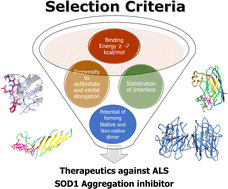A computational strategy for therapeutic development against superoxide dismutase (SOD1) amyloid formation: effect of polyphenols on the various events in the aggregation pathway†
Abstract
Pathology of superoxide dismutase 1 (SOD1) aggregation is linked to a neurodegenerative disease known as amyotrophic lateral sclerosis (ALS). Without suitable post-translational modifications (PTMs), the protein structure tends to become aggregation-prone. Understanding the role of PTMs and targeting the aggregation-prone SOD1 with small molecules can be used to design a strategy to inhibit its aggregation. Microsecond long molecular dynamics (MD) simulations followed by free energy surface (FES) analyses show that the loss of structure in the apo monomer happens locally and stepwise. Removing the disulfide bond from apoprotein leads to further instability in the zinc-binding loop, giving rise to non-native protein conformations. Further, it was found that these non-native conformations have a higher propensity to form a non-native dimer. We chose three structurally similar polyphenols based on their binding energies and investigated their impact on SOD1 aggregation kinetics. MD simulations of apo-SOD1SH/corkscrew fibril–polyphenol complexes were also carried out. The effect of polyphenols was seen on fibril elongation as well. Based on the experiments and MD simulation results, it can be inferred that the choice of inhibitors is influenced not only by the binding energy but also by dimer interface stabilization, the proclivity to form non-native dimers, the propensity to break fibrils, and the propensity to decrease the rate of elongation. The polyphenols with 3′ and 4′ hydroxyl groups are better inhibitors of SOD1 aggregation.



 Please wait while we load your content...
Please wait while we load your content...